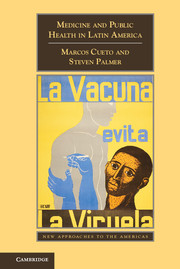Book contents
- Frontmatter
- Contents
- Acknowledgments
- Introduction
- Chapter One Indigenous Medicine, Official Health, Medical Pluralism
- Chapter Two National Medicines and Sanitarian States
- Chapter Three Making National and International Health
- Chapter Four Medical Innovation in the Twentieth Century
- Chapter Five Primary Health Care, Neoliberal Response, and Global Health in Latin America
- Conclusion
- Suggested Readings
- Index
- References
Chapter Three - Making National and International Health
Published online by Cambridge University Press: 05 December 2014
- Frontmatter
- Contents
- Acknowledgments
- Introduction
- Chapter One Indigenous Medicine, Official Health, Medical Pluralism
- Chapter Two National Medicines and Sanitarian States
- Chapter Three Making National and International Health
- Chapter Four Medical Innovation in the Twentieth Century
- Chapter Five Primary Health Care, Neoliberal Response, and Global Health in Latin America
- Conclusion
- Suggested Readings
- Index
- References
Summary
Over the course of the twentieth century, Latin America acquired a justifiable reputation as a place where the poor – and especially the rural poor – lacked adequate health services. At the same time, recent research into the history of national state health agencies and international health organizations in the region underlines how important Latin America was in staging the world’s first international health system. These two stories were intertwined. The link took place under the auspices of a large U.S. philanthropy, the Rockefeller Foundation (RF), and as part of an informal sanitary wing of U.S. foreign policy, which chose as an entry point into the sanitary concerns of many nations the fight against a widely dispersed rural affliction, ancylostomiasis (hookworm disease). Attempts to address specific issues of rural health and sanitation were core to this system, as was state modernization in the interests of hemispheric prosperity. To varying degrees, these health systems sought to incorporate new sectors into political life as well as to establish international contacts. While most of the non-Western world at this time was under the colonial rule of the United States, Japan, and the European powers, each with a distinct health apparatus governed by the logic of colonialism and formally subordinate to the metropole, the national states of Latin America generated something quite different. Their interactions with other Western states, and especially the United States, would provide the principal blueprint for the fully “international” health apparatus that emerged in the post–World War II era, when the nation-state became the global norm. Despite the growing influence of the United States in the region, university-trained professionals, working-class leaders, politicians, and middle-class elites struggled to find their own niche in postcolonial Latin America society by exploiting the possibilities of formal state sovereignty.
- Type
- Chapter
- Information
- Medicine and Public Health in Latin AmericaA History, pp. 106 - 156Publisher: Cambridge University PressPrint publication year: 2014

